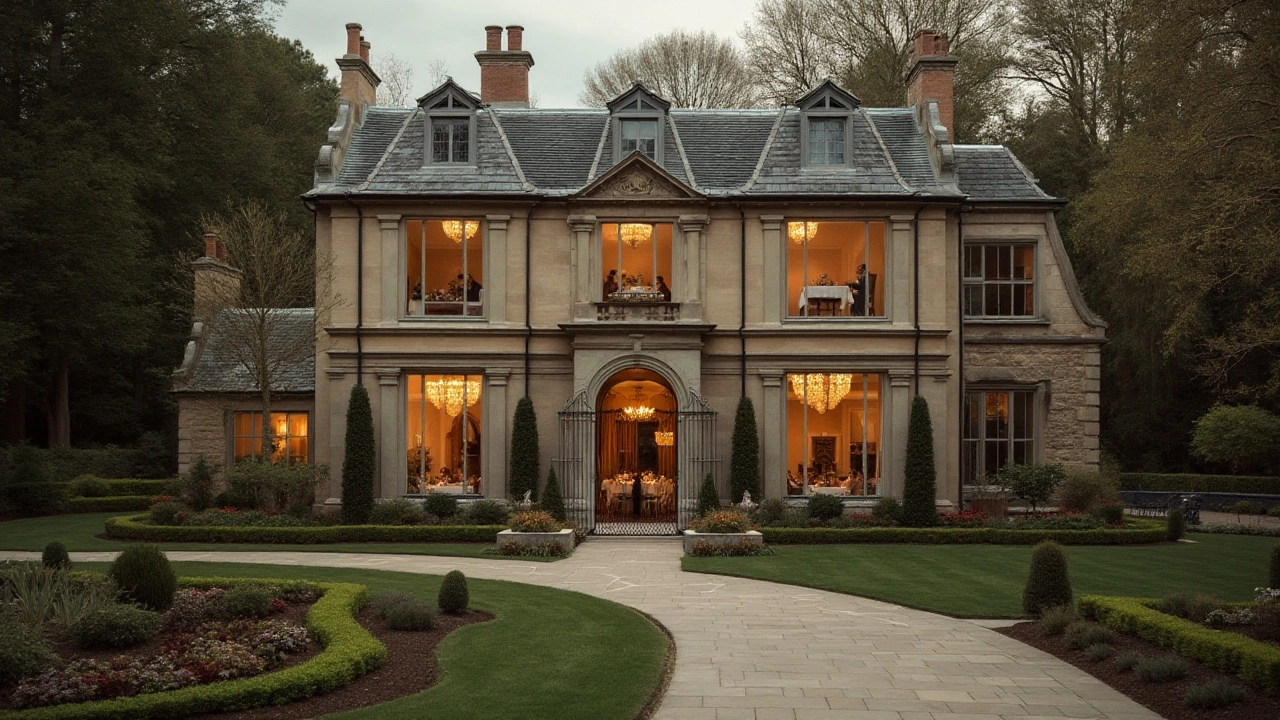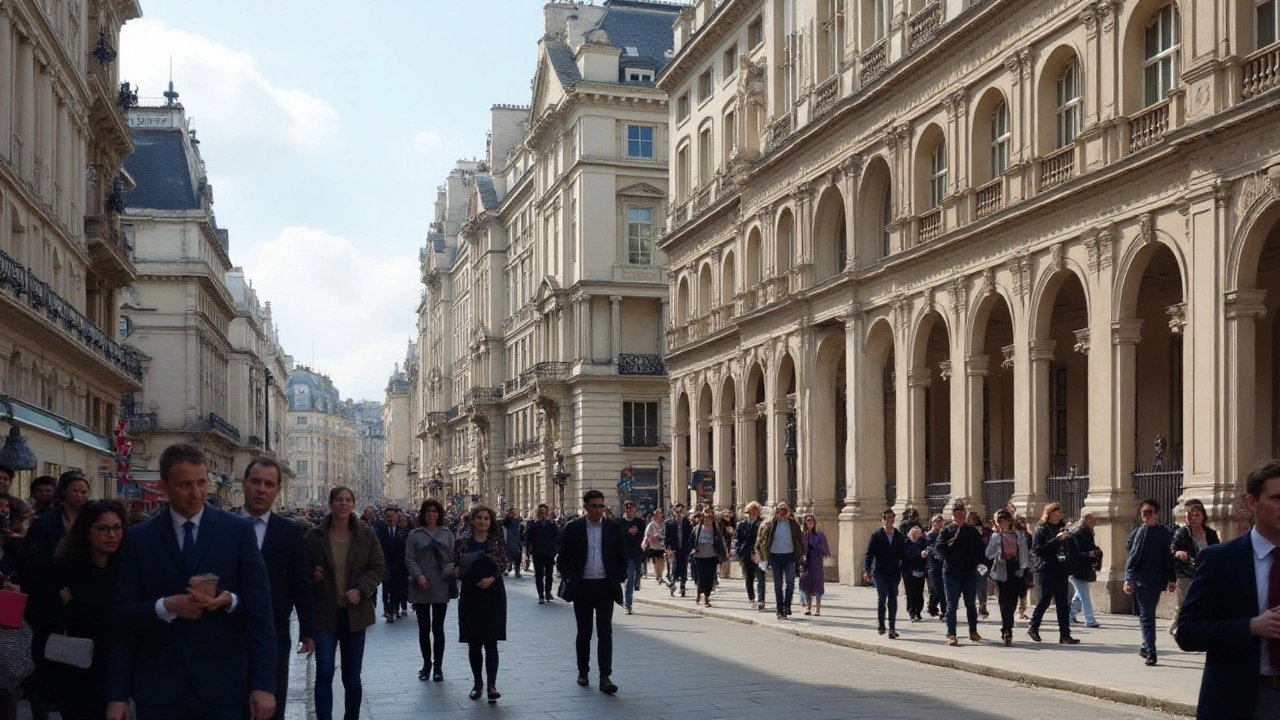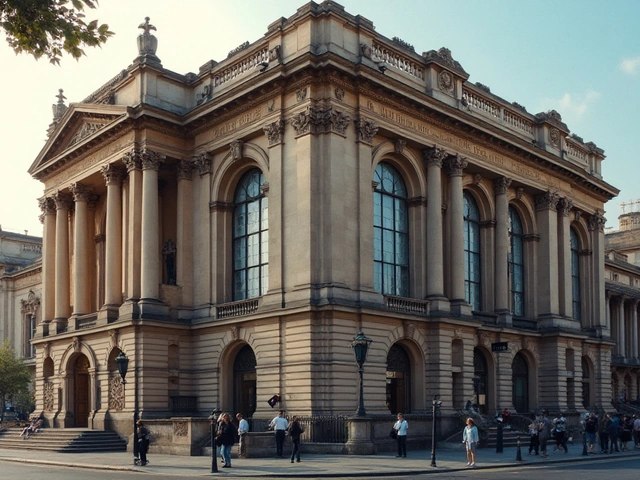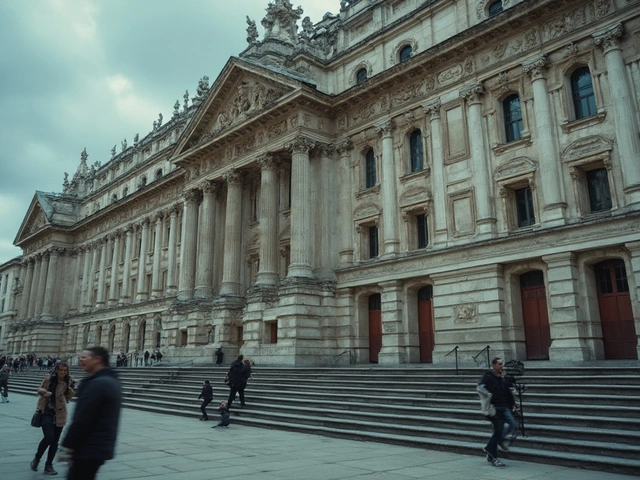When walking through cities like Paris, New York, or even Buenos Aires, one can't help but notice the grandiose and elegant buildings that stand as a testament to Beaux-Arts architecture. This style, which flourished from the late 19th century to the early 20th century, has profoundly influenced both public and private architecture around the world.
Beaux-Arts architecture originated from the École des Beaux-Arts in Paris, where architects were trained in classical principles with a focus on symmetry, grandeur, and elaborate details. These buildings often feature intricate sculptures, tall columns, and grand staircases, creating an air of sophistication and magnificence.
Many iconic buildings exemplify the Beaux-Arts style, such as the Paris Opera House, the Metropolitan Museum of Art in New York, and the Buenos Aires Central Post Office. These landmarks continue to be celebrated not just for their aesthetic appeal but also for their cultural significance.
In modern architecture, the influence of Beaux-Arts can be seen in the emphasis on symmetry, attention to detail, and the use of classical elements. While contemporary styles may lean towards minimalism, the principles of Beaux-Arts still provide valuable lessons in creating spaces that are both functional and beautiful.
Preserving these architectural treasures is vital for maintaining the cultural heritage they represent. Efforts to restore and maintain Beaux-Arts buildings ensure that future generations can continue to appreciate and learn from this influential style.
- Origins of Beaux-Arts Architecture
- Key Features and Elements
- Notable Examples Around the World
- Influence on Modern Architecture
- Preserving Beaux-Arts Heritage
Origins of Beaux-Arts Architecture
Beaux-Arts architecture, which means "Fine Arts" in French, finds its origins in the prestigious École des Beaux-Arts in Paris. Established in 1648, the school initially focused on painting and sculpture before incorporating architectural training in the late 17th century. It became one of the most influential architectural schools in the world by the 19th century. The school emphasized classical Greek and Roman styles, encouraging an architectural approach that merged grandeur, symmetry, and elaborate detail.
The turning point for Beaux-Arts architecture came during the mid-to-late 19th century. This period saw aspiring architects from Europe and Americas flocking to the École des Beaux-Arts. The training was rigorous, involving intense study of history, theory, and architectural design. Students engaged in exercises known as charrettes, or competitive design sessions, preparing them for real-world architectural challenges. This immersive education system cultivated architects who would go on to design some of the world's most iconic structures.
One of the school’s distinctive methods was the division between structure and ornament. Architects were taught to master the building's core before adding ornamental features. This approach led to the characteristic grandeur of Beaux-Arts buildings, which often feature extensive sculptural work, large staircases, and monumental facades. Famous architects like Charles Garnier, who designed the Paris Opera House, and Richard Morris Hunt, known for the facade of the Metropolitan Museum of Art in New York, were products of this intense training.
The arrival of Beaux-Arts architecture in America marked a significant milestone. American architects like Henry Hobson Richardson and McKim, Mead & White began incorporating Beaux-Arts principles into their designs, leading to structures such as the Boston Public Library and New York Public Library. The style became a symbol of cultural aspiration, blending Old World elegance with New World ambition.
Diversification within Beaux-Arts architecture can also be seen across continents. In Buenos Aires, for example, architects inspired by the École des Beaux-Arts designed landmark buildings such as the Central Post Office and the Palace of the Argentine National Congress. These structures highlight how Beaux-Arts principles adapted to local contexts, enriching cityscapes with their timeless appeal.
"The art school trained so many iconic architects who made significant contributions globally. Its influence is felt in almost every major city," once noted architectural historian Gerald Allen.
In the late 19th and early 20th centuries, major world expositions showcased Beaux-Arts architecture's possibilities. Events such as the 1893 World’s Columbian Exposition in Chicago were pivotal moments, drawing millions of visitors and influencing generations of architects. The exposition’s neoclassical and Beaux-Arts buildings, arranged in a harmonious urban plan, served as potent demonstrations of the style’s grandeur and beauty.
Beaux-Arts architecture represents a critical phase in architectural history, blending classical influences with modern technological advancements. Its roots in the École des Beaux-Arts have left an indelible mark on architectural education and design practices around the world. The principles of Beaux-Arts continue to inspire, reminding us of a time when architecture aimed not just to build, but to create grand and enduring works of art.
Key Features and Elements
Beaux-Arts architecture, also known as the Academic Classical style, is characterized by its grandiosity and elaborate design. Originating from the Parisian École des Beaux-Arts, architects trained in this style were taught to emphasize classical principles of symmetry, composition, and grandeur. A striking feature of this architectural style is its attention to detail, ensuring that every element has a purpose and contributes to the overall aesthetics of the building.
One of the most distinctive elements of Beaux-Arts architecture is its use of symmetry. Buildings designed in this style often have a highly symmetrical façade, balanced with evenly spaced windows and doors. This symmetry is not only visually pleasing but also represents the order and harmony architects sought to convey.
Another key element is the inclusion of elaborate decorative details. These details can include ornate sculptures, intricate carvings, and lavish moldings. Columns and pilasters often adorn the exteriors, and it’s common to see Corinthian or Ionic columns that add to the classical grandeur.
Grand staircases are another hallmark of Beaux-Arts architecture. These staircases aren't merely functional aspects of the building but are designed to be awe-inspiring. They often feature sweeping curves, elaborate railings, and detailed balustrades, making them focal points within the buildings.
The use of monumental forms and scale is another defining feature. Beaux-Arts buildings are typically large and dominating structures. For example, the New York Public Library and the Palais Garnier in Paris are not just substantial in size but are also visually commanding and luxurious in detail.
Material selection also plays a significant role in Beaux-Arts architecture. High-quality materials such as marble, stone, and fine wood are frequently used. These materials are chosen not only for their durability but also for their ability to convey elegance and luxury. Intricate patterns in stonework and polished surfaces are common sight in Beaux-Arts interiors.
The planning and layout of these buildings often follow classical principles as well. This includes the incorporation of axial symmetry in floor plans, with halls and corridors designed to lead the visitor towards a central focal point. This planning results in buildings that are easy to navigate and comprehend spatially.
Another feature one might notice is the inclusion of domes and/or large roofs. The dome, often situated in a central position, adds verticality and grandeur to the structure. The curvature and design of the dome symbolize both the sky and the idea of encompassing knowledge within.'
"Architects trained in the Beaux-Arts tradition were taught to design in a way that was both disciplined and artistic, incorporating a wealth of intricate decoration that spoke to the skill and mastery of the craft," said James Stevens Curl in his renowned book on architectural history.
These are some of the key features that make Beaux-Arts architecture an enduring and influential style. The elaborate details, symmetry, and grandiosity not only make each building stand out but also leave a lasting impression on the observer, reminding us of an era when architecture sought to blend art with functional design.

Notable Examples Around the World
In every corner of the world, you can find remarkable instances of Beaux-Arts architecture that have stood the test of time. These buildings not only exhibit the grandeur of the style but also serve as cultural icons within their respective cities. Let's take a journey through some of the most prominent examples of Beaux-Arts architecture.
The Paris Opera House, also known as the Palais Garnier, is a quintessential Beaux-Arts building. It was completed in 1875 and has since become a symbol of French culture and elegance. Designed by Charles Garnier, the building boasts an opulent facade adorned with sculptures, columns, and intricate detailing. Inside, the grand staircase and luxurious decorations continue to awe visitors.
Across the Atlantic, the Metropolitan Museum of Art in New York City showcases the Beaux-Arts style through its grandeur and attention to detail. Opened in 1902, the main building was designed by Richard Morris Hunt. The facade features classical elements such as Corinthian columns and elaborate sculptural details. The museum remains one of the world's most visited, revered not just for its collections but also for its architectural splendor.
In Argentina, the Buenos Aires Central Post Office stands as a testament to Beaux-Arts architecture in South America. Completed in 1928, the building was designed by French architect Norbert Maillart. The structure displays the elegance and symmetry typical of Beaux-Arts, with a grand entrance hall that impresses visitors with its size and beauty.
An often-overlooked example is the Royal Museum for Central Africa in Belgium. This museum, located in Tervuren, was designed by Charles Girault and completed in 1910. The building's ornate details and expansive grounds make it a prime example of the Beaux-Arts style's reach and impact. The museum's architecture serves as a reminder of Belgium's colonial history and artistic ambitions during that period.
The Beaux-Arts style is more than just a visual delight; it embodies a philosophy of harmony, tradition, and cultural aspiration. As architectural historian Edith Wharton reportedly said, 'The desire for perfection in design is rooted in the appreciation of beauty itself.'
These notable examples around the world share common characteristics—grandeur, symmetry, and intricate details—that make Beaux-Arts architecture so distinctive and timeless. By preserving these landmarks, we ensure that the legacy of Beaux-Arts continues to inspire and educate future generations on the importance of beauty in our built environments.
Influence on Modern Architecture
Beaux-Arts architecture has left an enduring mark on modern architectural designs. While contemporary buildings may not mirror the opulence of the late 19th and early 20th centuries, the principles established by Beaux-Arts continue to inspire today's architects. One significant concept is the emphasis on symmetry. Modern architects often align elements to create balanced and aesthetically pleasing spaces, a direct nod to Beaux-Arts methodology. This principle is evident in many modern plazas, public buildings, and even in urban planning.
The use of grandiose spaces and monumental scale, key characteristics of Beaux-Arts architecture, can also be seen in contemporary designs. Current architects adopt these concepts to create impressive public spaces that convey a sense of importance and cultural value. Museums, government buildings, and even corporate headquarters frequently borrow from this playbook, incorporating vast atriums and majestic facades into their plans. The National Gallery of Art in Washington, D.C., for example, integrates these elements beautifully.
Another crucial aspect is the attention to detail and decorative elements. Beaux-Arts buildings are known for their intricate ornamentation, from sculptures to detailed friezes. In modern architecture, while the decorative aspects may be more subtle, the commitment to detail remains unchanged. Modern buildings often feature meticulous design elements that enhance both aesthetic and function. For instance, the modern revival of decorative metalwork and detailed masonry can be traced back to Beaux-Arts influences.
A striking example of Beaux-Arts influence on contemporary architecture is the Hearst Tower in New York City. Norman Foster’s innovative design for the tower’s expansion honors the original Beaux-Arts structure by Joseph Urban. Combining classical and modern elements, the new glass and steel façade respects the historic base while introducing a sleek and energy-efficient design. This melding of old and new highlights how Beaux-Arts principles can coexist with cutting-edge technology.
Design schools today still teach Beaux-Arts fundamentals, emphasizing the need for a harmonious relationship between a building’s form and its function. While the styles have evolved, the foundational lessons of proportion, scale, and decorative elements continue to be central to contemporary architectural education. This educational tradition ensures that the influence of Beaux-Arts architecture will persist in future designs.
To understand how deeply Beaux-Arts affects modern architecture, we can look at how public spaces are designed. Urban planners often use principles of order and symmetry, creating harmonious and functional layouts. Central Park in New York is an example where these ideas manifest, with its orderly pathways and beautifully balanced landscapes, illustrating the lasting impact of Beaux-Arts.
“The grandeur of Beaux-Arts architecture continues to inform and inspire modern designs, reminding us of the timeless appeal of balance, order, and beauty,” says Charles Jencks, a renowned architectural historian.
In commercial architecture, the emphasis on grand entrances and monumental staircases can also be seen. Companies aim to make strong first impressions, and what better way than to walk into a lobby that exudes the same majestic aura found in a Beaux-Arts structure? An example can be found in the headquarters of major corporations like Apple and Google, where grandiose and thoughtfully designed spaces are created to impress and inspire.
Finally, the preservation and restoration of original Beaux-Arts buildings are crucial. These efforts not only save architectural treasures but also provide inspiration for new projects. Restored buildings like the Grand Palais in Paris or the Public Library in New York serve as living museums, educating the public and reminding us of the elegance and importance of architectural heritage. By keeping these gems alive, we ensure that the Beaux-Arts architectural influence continues to thrive, inspiring architects and designers for generations to come.

Preserving Beaux-Arts Heritage
Preserving the grand structures that embody Beaux-Arts architecture is essential in maintaining the architectural and cultural fabric of our cities. These historic buildings, often adorned with intricate carvings, massive columns, and grand staircases, tell stories of an era gone by and continue to inspire contemporary design. From public libraries to private mansions, the meticulous details that define Beaux-Arts make their preservation both a challenging and rewarding endeavor.
One of the first steps in preserving these landmarks is identifying and cataloging all existing Beaux-Arts structures. This involves extensive research and collaboration with local historical societies and governmental agencies. Once identified, the buildings are often placed on historical registers, which afford them certain protections and make them eligible for grants and funding aimed at preservation. A notable example is the Metropolitan Museum of Art in New York, which, thanks to preservation efforts, continues to serve as a beacon of art and architecture.
It's imperative to restore these buildings with materials and techniques that are as close to the original as possible. This includes using the same type of stone, wood, and paint to maintain the building's authenticity. Advances in technology have provided preservationists with tools to better analyze and replicate the original materials used in these constructions. For example, 3D scanning and printing technologies can create precise replicas of intricate sculptures and moldings that have decayed over time.
The role of community engagement in preservation cannot be overstated. By involving local communities in the restoration process, there's a stronger appreciation and a sense of ownership over the heritage. Educational programs, guided tours, and workshops can be instrumental in fostering this connection. An interesting statistic is that buildings listed on the National Register of Historic Places in the United States receive an average of 12% more in tourism revenues than those that are not, demonstrating the economic benefits of preservation alongside cultural ones.
Funding is another critical aspect of preservation efforts. While governmental grants and funds from historical societies play a significant role, private donations and corporate sponsorships can provide much-needed resources. Philanthropic contributions often come with conditions that align with the donor's interests, ensuring that preservation goals are met with the necessary financial support.
One of the most fascinating aspects of preserving these structures is adapting them for modern use without compromising their historical integrity. For example, the Palais Garnier in Paris, originally built as an opera house, now hosts a variety of events, including ballets and concerts, ensuring that the building remains relevant and functional in today's society. Adapting historical buildings to new uses helps sustain them financially and keeps them integrated into the community's daily life.
Public awareness campaigns also play a crucial role in preservation efforts. By informing the public about the significance of Beaux-Arts architecture through media campaigns, social media, and public events, there is greater support for preservation initiatives. A famous quote by Gustave Eiffel encapsulates this sentiment:
"The preservation of these masterpieces is not just about protecting stones; it’s about safeguarding our cultural soul."
In conclusion, the diligent and passionate efforts to preserve Beaux-Arts architecture ensure that these grand structures will continue to stand as testaments to human creativity and ingenuity. By identifying, restoring, and adapting these buildings for modern use, and engaging the community, we can maintain the legacy of Beaux-Arts for future generations to marvel at and learn from.




